Traffic Shaping - PowerPoint PPT Presentation
Title:
Traffic Shaping
Description:
New peer-to-peer file sharing applications emerge regularly ... How can we limit peer-to-peer traffic without starving out other traffic? Motivation ... – PowerPoint PPT presentation
Number of Views:22
Avg rating:3.0/5.0
Title: Traffic Shaping
1
Presentation by Mark Meiss (mmeiss_at_iu.edu) January
2002
Workstation-Based Traffic Shaping
2
Motivation
- New peer-to-peer file sharing applications emerge
regularly - The need for traffic shaping is greater than ever
- How can we limit peer-to-peer traffic without
starving out other traffic?
3
Problems with Shaping
- Many shapers rely on application signatures for
shaping - Often, a signature is just a port number
- Remember learning that port 6699 equals Napster?
4
The Port 80 Effect
- As traffic shaping becomes more widespread,
peer-to-peer applications will start tunneling
through TCP port 80 - The traffic we want to shape will become
indistinguishable from other traffic - Packet snooping is too difficult and isnt likely
to help in the long term
5
Our Proposal
- Shape traffic based on different factors
- Apparent amount of demanded bandwidth
- Destination IP address
- Create a notch filter so that users of
interactive applications suffer the least packet
loss - E-mail users shouldnt notice the congestion
6
Our Proposal (cont.)
- Use BGP routes to classify data according to
destination - Dont worry about port numbers or packet data at
all - Our claim A good PC running an open-source OS
can shape traffic at least 200,000 packets/sec
7
User-Based Model
User-Based Mathematical Model of Network Activity
8
Sample Run Bandwidth
9
Sample Run Performance
10
Sample Run User Effects
11
Sample Run Zoom In
12
Implementation
- Development platform is Pentium III system with
64-bit 66MHz PCI slots, running Redhat Linux 7.2 - Software platform is the Click Modular Router
- http//www.pdos.lcs.mit.edu/click/
13
What Next?
- Real-world testing in a few months
- Goal is to get as close to Gigabit line rate as
possible - Also working on benchmarking performance of Fast
Ethernet and Gigabit NICs - Early results suggest large performance
differences - Feedback and suggestions for additional shaping
parameters are welcome































